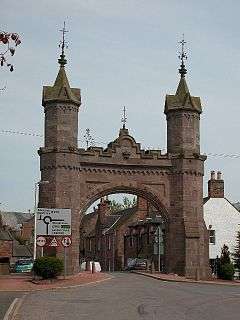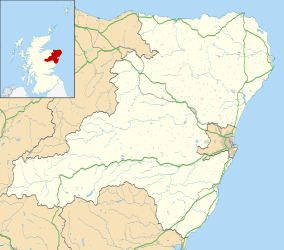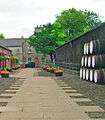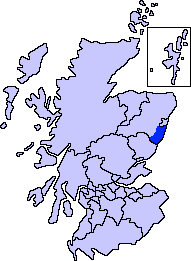Fettercairn
Fettercairn (/ˌfɛtərˈkɛərn/, Scottish Gaelic: Fothair Chàrdain) is a small village in Aberdeenshire, Scotland,[1][2] northwest of Laurencekirk in Aberdeenshire on the B966 from Edzell. Fettercairn is also reached via the Cairn O' Mount road (B974) from Deeside.
Fettercairn
| |
|---|---|
 Royal Arch by John Milne | |
 Fettercairn Location within Aberdeenshire | |
| OS grid reference | NO650734 |
| Council area | |
| Lieutenancy area | |
| Country | Scotland |
| Sovereign state | United Kingdom |
| Post town | LAURENCEKIRK |
| Postcode district | AB30 |
| Police | Scotland |
| Fire | Scottish |
| Ambulance | Scottish |
| UK Parliament | |
| Scottish Parliament | |
The name comes from the Scottish Gaelic Fothair and the Pictish carden and means "slope by a thicket". The name appeared as Fotherkern in c. 970.[3]
Overview
The shaft of the old 16th century Kincardine Mercat cross stands in the square,[4] and is notched to show the measurements of a Scottish ell. Nearby the ruins of the long since abandoned county town and royal castle of Kincardine (Gaelic: Cinn Chàrdainn meaning "The head of the copse", including the Pictish word carden, "copse" ) similarly Fettercairn (Gaelic: Fothair Chàrdainn meaning "Shelving or terraced slope at the copse", containing Pictish carden) Kincardine stood about 2 miles (3 km) northeast of Fettercairn, and by the end of the 16th century had declined to a mere hamlet, being represented now only by xv. 26 the ruins of the royal castle and an ancient burial-ground.
A memorial archway erected in 1864 commemorates the 1861 visit by Queen Victoria and Prince Albert, while staying at Balmoral. Leaves from the journal of our life in the highlands describes aspects of their visit. Queen Victoria writes "At a quarter-past seven o'clock we reached the small quiet town, or rather village, of Fettercairn, for it was very small-not a creature stirring, and we got out at the quiet little inn, "Ramsay Arms" quite unobserved". "Louis and General Grey had rooms in an hotel, called "The Temperance Hotel" opposite". "The evening being bright and moonlight and very still, we all went, and walked through the whole village, where not a creature moved:- through the principal little square, in the middle of which was a sort of pillar or Town Cross on steps, and Louis read, by the light of the moon, a proclamation for collections of charities which was stuck on it". "Suddenly we heard a drum and fifes!". "As we walked slowly back, we heard the noise from time to time- and when we reached the inn door, we stopped and saw six men march up with fifes and a drum (not a creature taking any notice of them), go down the street and back again". "Albert asked the little maid, and the answer was, "It's just a band" and that it walked about in this way twice a week. How odd! It went on playing some time after we got home".
Historically Fettercairn lies at the southern end of the Monboddo Estate, where the Scottish philosopher and precursor of evolutionary thought, James Burnett, Lord Monboddo, lived. Fettercairn houses the Fettercairn distillery (owned by Whyte and Mackay Ltd.) that produces the "Fettercairn 1824" single malt whisky.
Gallery
- St Martins Church
 Fettercairn distillery.
Fettercairn distillery.
See also
References
- Ordnance Survey: Landranger map sheet 45 Stonehaven & Banchory (Map). Ordnance Survey. 2014. ISBN 9780319231685.
- "Ordnance Survey: 1:50,000 Scale Gazetteer" (csv (download)). www.ordnancesurvey.co.uk. Ordnance Survey. 1 January 2016. Retrieved 18 February 2016.
- Mills, A.D. (2011) [first published 1991]. A Dictionary of British Place Names (First edition revised 2011 ed.). Oxford: Oxford University Press. p. 187. ISBN 9780199609086.
- Chisholm, Hugh, ed. (1911). . Encyclopædia Britannica. 10 (11th ed.). Cambridge University Press. p. 296.
External links


